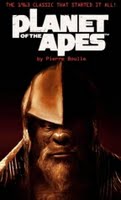 Planet of the Apes
Planet of the Apesby Pierre Boulle
originally published in 1963
This 2000 edition published by Gramercy Books
Recently I set myself down in front of my television and watched a marathon of all the "Planet of the Apes" movies and was amazed at how they were still good after all these years. I also noticed how some of the social commentary was still applicable. While watching the credits roll on all the films I kept seeing that they were all based on the novel by Pierre Boulle, and being the avid reader/autodidactic I am, I decided to read the novel. This novel is a classic, I've discovered and should be required reading for our youth because, while the 6 films touched on some social commentary, issues like racism, class divisions, vivisection, and the dangers of close-mindedness, Pierre Boulle had all this wrapped in this one 191 page novel.
Basically if you take all the concepts from the films (except for "Beneath the Planet of the Apes") you get this one story. It's odd how all the films have a touch of some of the original novel but not one single movie had all the action/concepts. Also only 4 characters from the book made it to the original 70s era movies and Tim Burton's Planet of the Apes from 2001 added one more character from the novel. Those characters are; Cornelius, Zira, Zaius, Nova and Hector. In the 2001 film Hector played an important part but in the novel the Earth chimp is killed not long after landing on the Planet of the Apes.
Here's the story in a nutshell. Jinn and Phyllis, a couple out on a pleasure cruise in a spaceship, find a message in a bottle floating in space. The message inside the bottle is the testimony of a man, Ulysse Mérou, who has written down his story in the hope that someone else, somewhere, will find it. Ulysse begins by explaining that he was a friend of Professor Antelle, a genius scientist on Earth, who invented a spaceship that could travel at nearly the speed of light. Ulysse, the professor, and a physicist named Levain fly off in this ship to explore outer space. They travel to the nearest star system that the professor theorized might be capable of life, the red sun Betelgeuse, which would take them about 350 years to reach. Due to time dilation, however, the trip seems to the travelers only to last two years.
Upon landing on this planet in the Betlguese system, which they name Soror, the astronauts see signs of civilization but find that the humans are like wild animals living in the jungle and without the ability of speech. After the humans discover the astronauts they go wild and attack the landing craft, destroying it and the clothes, which the humans don't wear on this planet. The astronauts "go native" in order to understand this society. Soon it is discovered that the humans aren't the dominate race, when a gorilla hunting party begins trapping and killing humans.
Ulysse manages to escape being killed only to be trapped, caged and taken to some chimpanzee scientists. Levain is killed and the fate of Professor Antelle is unknown at this time.
Ulysse at first observes the ape culture then finds an ally in Zira, a chimpanzee scientist. Zira and Cornelius (her fiance), plan to show Ulysse at a scientific forum, to help prove Cornelius theories of evolution. Soon Ulysse becomes somewhat of a celebrity among the apes and is treated like an ape (like the apes were in "Escape from the Planet of the Apes"). Not long after Ulysse is exposed to the ape culture, a strange archaeological site is found to show that humans were once the dominant species and that out of laziness became the lower life form and the apes took over in an uprising (like in the last 2 movies of the original series;"Conquest..." & "Battle...").
Soon Zira, Cornelius and Ulysse learns the scientists want to destroy all evidence of humans once being dominant, that includes Ulysse, so they plan his escape. One thing at this point I should point out is that the Apes on Soror are not the same as in the movies, they are technologically advanced and just beginning to send satellites into space. Yep, the apes drive cars and fly planes.
This book has a great twist ending, although it is nowhere near the Charlton Heston scene with the Statue of Liberty, it is a bit of a surprise.
No comments:
Post a Comment